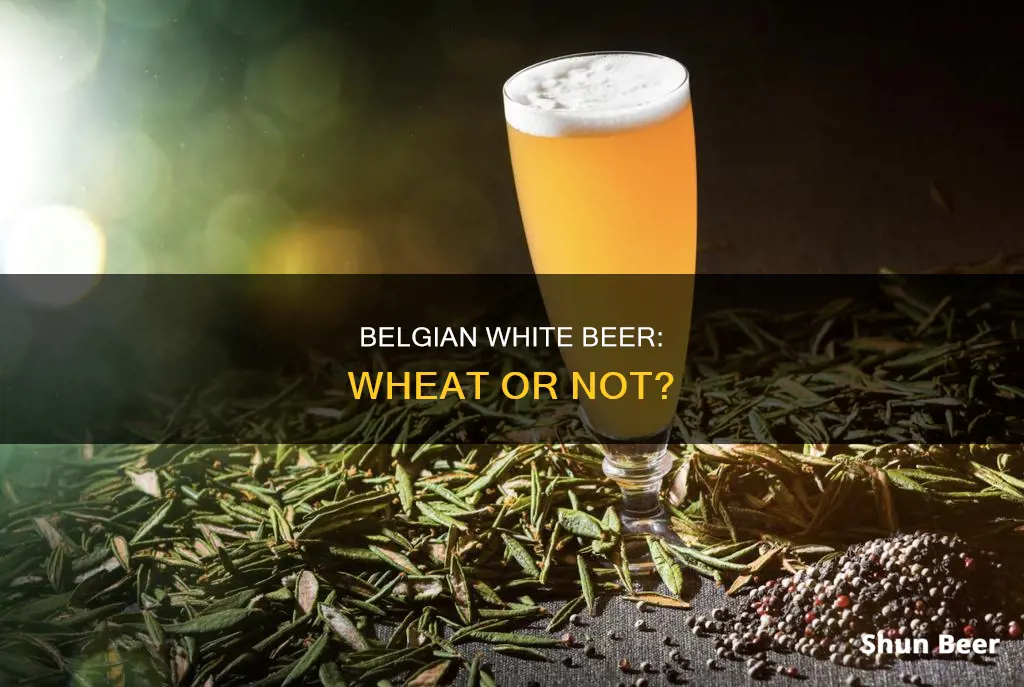
Belgian white beer, also known as witbier (Dutch for white beer), is a style of wheat beer that originated in the Flemish region of Belgium and dates back to the Middle Ages. It is brewed using unmalted wheat, sometimes oats, and malted barley, and is spiced with coriander and orange peel. Belgian white beers are known for their refreshing taste and are particularly popular during the summer months. They typically have a lower percentage of alcohol than other beers, making them a good choice for social gatherings.
What You'll Learn
- Belgian wheat beer is a descendant of beers from the medieval duchy of Brabant
- Witbier (Dutch for white beer) uses flavourings like coriander and orange peel
- Belgian white beers are made with raw, unmalted wheat
- Witbier is an unfiltered, top-fermented style of wheat beer
- Belgian-style witbier is enjoying a renaissance, especially in the American market

Belgian wheat beer is a descendant of beers from the medieval duchy of Brabant
Wheat beer is a top-fermented beer brewed with a large proportion of wheat relative to the amount of malted barley. The two main varieties are German Weizenbier and Belgian witbier. Belgian witbier, or "white beer", is a direct descendant of beers from the medieval duchy of Brabant.
Belgian wheat beer, or white beer, is made with raw unmalted wheat. It is termed "white beer" because "wheat" has the same etymological root as "white" in most West Germanic languages, including English. The name "witbier" also comes from the Dutch word for "white beer". The beer gets its name from the suspended yeast and wheat proteins, which cause the beer to look hazy or white when cold.
Belgian white beers usually include unmalted wheat as an adjunct, spices, and sometimes oats. The percentage of unmalted grains in the grist can approach 50%, though 30% to 40% is more common. The style was revived by Pierre Celis at the Hoegaarden Brewery in Belgium. Celis had worked at the Tomsin brewery in Hoegaarden, the last witbier brewery in Belgium, which closed its doors in 1955. Hoegaarden white beer soon became quite popular and has been emulated by many brewers in Belgium and around the world.
Belgian wheat beer is generally made with a 50/50 distribution of unmalted wheat and malted barley. It is re-fermented in the bottle and generally has a fresh taste, making it a good thirst quencher during the summer. The beer had almost disappeared in the 1960s, but was brought back to life by Pierre Celis in Hoegaarden, from where it began to play an important role in the Belgian beer landscape. In the 1980s, the style was also taken over by Dutch and French breweries and later by breweries in countries such as Canada, the United States, and Scandinavia.
Lagers and Wheat Beers: What's the Difference?
You may want to see also

Witbier (Dutch for white beer) uses flavourings like coriander and orange peel
Wheat beer is a top-fermented beer brewed with a large proportion of wheat relative to the amount of malted barley. The two main varieties are German Weizenbier and Belgian Witbier. Belgian white beers are often made with raw unmalted wheat.
Witbier, which is Dutch for "white beer", is a barley/wheat, top-fermented beer brewed mainly in Belgium and the Netherlands. It gets its name from the suspended yeast and wheat proteins, which make the beer appear hazy or white when cold.
Witbiers use flavourings such as coriander and orange peel. Coriander is added to the boil, and orange peel is added to the boil or fermenter. Some brewers also add other citrus peels, such as lemon and lime. The yeast used in Witbiers produces a unique fruity and spicy flavour, and the beer is usually slightly tart, with a refreshing taste.
Witbiers are typically between 4.5% and 5.4% ABV, although stronger "grand cru" versions can have between 8% and 10% ABV. They are usually served unfiltered and cloudy, although some prefer to filter out the yeast and wheat proteins to create a clear beer.
The Longevity of White Wheat Beers Explored
You may want to see also

Belgian white beers are made with raw, unmalted wheat
Wheat beer is a top-fermented beer brewed with a large proportion of wheat relative to the amount of malted barley. The two main varieties are German Weizenbier and Belgian Witbier. Belgian white beers are made with raw, unmalted wheat.
Belgian Witbier, also known as "white beer", originated in the Middle Ages in Belgium and is unique when compared to other traditional wheat beers, such as those of Germany. While German white or wheat beers are made with only malted wheat, malted barley, and hops, Belgian white beers typically include raw, unmalted wheat, as well as spices and sometimes oats. The use of unmalted wheat as an adjunct gives Belgian white beers a unique character.
The name "white beer" or "witbier" comes from the Dutch word "wit", meaning white, and refers to the cloudy, white appearance of the beer in a glass. This cloudiness is caused by suspended yeast and wheat proteins. The style is believed to have originated in the Flemish region of Belgium, where brewers had access to cereal grains and spices from neighbouring farms and the Netherlands.
Belgian white beers typically contain a blend of spices such as coriander and orange peel, which contribute to their distinctive flavour profile. They may also include other grains such as oats or spelt. The percentage of unmalted grains in the grist can approach 50%, though 30% to 40% is more common.
The revival of Belgian white beers in the 1960s is attributed to Pierre Celis, a brewer from Hoegaarden, Belgium. Since then, the style has gained popularity and is now enjoyed worldwide, with a particularly strong following in the American market.
Wheat Beer and Fiber: A Healthy Match?
You may want to see also

Witbier is an unfiltered, top-fermented style of wheat beer
Wheat beer is a top-fermented beer brewed with a large proportion of wheat relative to the amount of malted barley. The two main varieties are German Weizenbier and Belgian Witbier. Belgian white beers are often made with raw, unmalted wheat.
Witbier, or Wit, is a style of wheat beer that originated in Belgium. It is an unfiltered, top-fermented beer, which is brewed mainly in Belgium and the Netherlands. The name Witbier means "white beer" in Dutch. The name comes from the suspended yeast and wheat proteins, which cause the beer to look hazy or white when cold. The haze is mainly protein with a small amount of yeast.
Belgian Witbier is traditionally made with up to 50% raw wheat rather than wheat malt. It also usually contains a blend of spices, such as coriander, orange, and bitter orange. The style was revived by Pierre Celis at the Hoegaarden Brewery in Belgium and the Celis Brewery in the United States.
Witbiers are generally bottle-conditioned and served cloudy. They are also less bitter than other beers, achieved by using a small quantity of hops. The appearance of a traditional Witbier is very pale yellow in colour with a slight haziness and a rich, foamy head. The aroma is citrusy, spicy, and fruity, and the body is light. The taste is slightly tart, but balanced with light malt and wheat flavours, as well as complex citrus and spice notes for a refreshing taste. The alcohol content of traditional Witbier is between 4.5% and 5.0% ABV, although some stronger grand cru versions have between 8% and 10% ABV.
Crafting Wheat Beer: Adding Unique Flavors to Your Brew
You may want to see also

Belgian-style witbier is enjoying a renaissance, especially in the American market
Belgian-style witbier, also known as "white beer", is a top-fermented wheat beer that originated in Belgium in the Middle Ages. It is brewed using unmalted wheat, sometimes oats, and malted barley, and spiced with coriander and orange peel. The style fell into obscurity until it was revived by Belgian brewer Pierre Celis in the 1960s. Today, it is enjoying a renaissance, particularly in the American market.
The decline of white beer began in the early 1900s with the advent of golden lager, and by the 1950s, the last white beer brewery in Hoegaarden, Belgium had closed its doors. However, Celis, a milkman from Hoegaarden, started a new brewery called De Kluis in the mid-1960s, dedicated to brewing a white beer called Hoegaarden. He had worked at the Tomsin brewery in Hoegaarden as a young man and remembered the taste of white beers, which he recreated at his new brewery. Hoegaarden white beer soon became popular and has since been emulated by many brewers in Belgium and around the world.
From the 1990s onwards, white beer production increased significantly, with two commercially available examples leading the way: Hoegaarden, a traditional Belgian-style white beer, and MillerCoors' Blue Moon Belgian White, a "Belgo-American-style" white beer. Blue Moon, in particular, brought greater attention to the style in the United States, where it is spiced with coriander and Valencia orange peel and has a cloudy gold appearance.
Belgian-style witbiers are now widely available in the United States, with several breweries offering their own takes on this classic style. Examples include Shock Top Belgian White Ale, Blue Moon Belgian White Ale, Hoegaarden Witbier Blanche, and New Belgium Fat Tire Belgian White. These beers are characterised by their fruity, coriander, and orange peel flavours, and are often served with a garnish of orange to highlight their citrus aroma.
The renaissance of Belgian-style witbier in the American market has brought new life to this centuries-old style of beer, introducing it to a new generation of beer drinkers and helping to preserve its place in the world of craft beer.
Wheat Beers: Heavy, Bitter, or Both?
You may want to see also
Frequently asked questions
Belgian white beer, also known as witbier (Dutch for "white beer"), is a style of wheat beer that originated in Belgium in the Middle Ages. It is brewed using unmalted wheat, sometimes oats, and malted barley, and spiced with coriander and orange peel.
German wheat beers are made with only malted wheat, malted barley, and hops, whereas Belgian white beers typically include unmalted wheat, spices, and sometimes oats.
Some examples of Belgian white beers include Hoegaarden Witbier, Blanche De Bruxelles, St. Bernardus Wit, and Brugs White Beer.
Belgian white beers are known for their refreshing taste, with a balance of light malt and wheat flavours, as well as complex citrus and spice notes. They are typically less bitter than other beers due to the small quantity of hops used.







